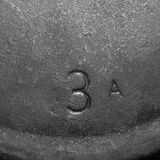Numbers & Letters
 Regardless of what other markings or logos the major foundries incised into their products, common among nearly all vintage pieces-- whether they be skillets, dutch ovens, waffle irons, or griddles-- are size numbers.
Regardless of what other markings or logos the major foundries incised into their products, common among nearly all vintage pieces-- whether they be skillets, dutch ovens, waffle irons, or griddles-- are size numbers.
Often, the assumption is erroneously made that the large numeral, found normally either on the top of the handle or on the bottom of a piece, indicates its diameter in inches. A measurement of both the top and the bottom rim of a pan, however, will quickly confirm that the number has no direct correlation to either dimension.
 With the advent of wood-burning stoves, pans were produced to conform to the sizes of the openings in their tops known as "stove eyes". Think of a stove eye as a burner on a modern stove. (Some people still call them that.) A heavy cover piece was left in place when an eye was not directly in use, and removed-- using a special, heat-resistant lifter handle-- when maximum heat from the eye was required.
With the advent of wood-burning stoves, pans were produced to conform to the sizes of the openings in their tops known as "stove eyes". Think of a stove eye as a burner on a modern stove. (Some people still call them that.) A heavy cover piece was left in place when an eye was not directly in use, and removed-- using a special, heat-resistant lifter handle-- when maximum heat from the eye was required.
Heat rings, the rims protruding from the bottom circumference of most early cast iron pans, served multiple functions: as a "seal" of sorts between the pan and stove eye, as added stablility for less-than-perfectly flat pan bottoms, and as a device to help reduce hot spots.
Depending on the brand of stove, and the sizes of its various eyes, appropriately-sized pans would need to be purchased for use with it. Or, in some cases, the stove maker also produced pans, which they supplied for use with their units.
Even after gas-fired ranges-- and, eventually, electric stoves-- became ubiquitous, cast iron cookware continued to be manufactured in the sizes and with the designations originally established for its use on wood-burning stoves.
A 1924 Wagner Manufacturing Co. catalog gives these as the bottom diameters of their regular cast iron skillets:
|
#2 - 4-7/8"
#3 - 5-1/2" #4 - 5-7/8" #5 - 6-3/4" #6 - 7-1/2" |
#7 - 8-1/4"
#8 - 8-7/8" #9 - 9-3/4" #10 - 10-1/4" #11 - 10-7/8" |
#12 - 11-3/4"
#13 - 12" #14 - 13" |
These exact dimensions, however, were not standard across all makers. A 1918 Griswold Mfg. Co. catalog lists roughly the same dimensions for its regular skillets, with the #3 and #4 being somewhat smaller than Wagner's, and the #13 and #14 somewhat wider. And a Martin #3 skillet is the same size as a Wagner #2.
Some manufacturers even went so far as to intentionally make their pans a fraction of an inch wider than those of their competitors, so they could advertise them as being larger.
In its later years of production, Birmingham Stove & Range Co. downsized certain pans slightly in order to double the efficiency of its automated molding line, and altered others to accomodate the use of third party glass covers.
Things can become more confusing when you start noticing inscriptions like "3B" or "8CX", or "710D" or "1053C" on pieces. Let's take a moment to demystify those.
The letter or letters after the numerals, in all four cases, are what are known as pattern letters. Each model of pan a foundry produced had to have at least one pattern from which to make its molds. In the case of a popular-size pan, multiple working patterns would be created in aluminum so that runs of several at a time could be cast more quickly and efficiently. Over time, the patterns would wear or suffer damage, the result of which would end up being cast into the pan. It was important, therefore, to know which pattern currently in use was creating sub-standard pieces. A unique letter stamped into each working pattern provided the solution.
Some pieces may have only required a few patterns to fulfill manufacturing demand, so one would not expect to see those pieces with anything other than the first few letters of the alphabet. For popular pieces, like the size #3 and #8 skillets, you may see nearly every letter used.
You're also likely to see pieces with no letter following the number. There's nothing special about them; they're merely pieces cast using one more pattern in whatever group of which it was a part. The lack of a letter doesn't necessarily indicate its order of creation or usage, nor any kind of superiority to the other patterns of its type with letters on them. The letters do not represent pattern design revisions, but only served to identify which individual pattern among several was used to make which pans. The creation of a pattern with no letter just meant one more pattern that could be used for high-demand piece production. The lack of a letter may also mean there was only one pattern required to be created or used at a time for that particular piece.
Regardless of what an online auction description may state or even imply about them, collectors don't care what pattern letter appears on a piece, unless they happen to be trying to acquire one of each just for fun.
But what about "710D" and "1053C"? Those can't be size numbers.
 As cast iron manufacture became a national (and subsequently international) enterprise, systems were necessary to insure all parties involved knew exactly what was being bought and sold. In the case of Griswold, in addition to model or item numbers, "pattern numbers" were devised, ostensibly unique to each model, size, and type of pan produced. Griswold pieces like skillets and dutch ovens are inscribed with their size number and a pattern number. Other Griswold pieces like gem and muffin pans have both an item number and a pattern number inscribed in them. The Griswold pattern number is then appended with a letter unique to each working pattern.
As cast iron manufacture became a national (and subsequently international) enterprise, systems were necessary to insure all parties involved knew exactly what was being bought and sold. In the case of Griswold, in addition to model or item numbers, "pattern numbers" were devised, ostensibly unique to each model, size, and type of pan produced. Griswold pieces like skillets and dutch ovens are inscribed with their size number and a pattern number. Other Griswold pieces like gem and muffin pans have both an item number and a pattern number inscribed in them. The Griswold pattern number is then appended with a letter unique to each working pattern.
Wagner called theirs "catalog numbers". Typically appended by a letter, the catalog number then identified both the item or model and the unique working pattern.
To someone knowledgeable about the manufacturer, it's easy to tell that a Wagner pan marked "1053C" is a regular skillet (105x), size #3 (xxx3), made from the pattern for it lettered "C". Wagner even let a mathematical rule apply when the size number became two digits. Sizes #10 thru #14 skillets were therefore inscribed... That's right, "1060", "1061", "1062", "1063", and "1064".
Griswold's pattern numbering system is a little more cryptic, with the numbers appearing to have nothing to do with the size. A size #6 Griswold skillet, for example, is pattern number "699", a size #7 is pattern "701", and a size #8 is pattern "704". A number 273 corn stick pan is pattern number 930, which might seem a little redundant, as there is no other item 273 nor pattern 930.
A minor point of confusion is that pattern numbers in rare cases are not unique to a particular model pan. Griswold, for example, had the same number on multiple, dissimilar pieces. Wagner is also known to have had some duplication of catalog numbers.
 Some early pieces are seen with multiple pattern numbers on the same size and type of pan, and this may help explain how Griswold's pattern numbering ended up as it did. For example, as many five or six different numbers appear on the early Erie skillets:
Some early pieces are seen with multiple pattern numbers on the same size and type of pan, and this may help explain how Griswold's pattern numbering ended up as it did. For example, as many five or six different numbers appear on the early Erie skillets:
- #6 (699*, 700, 701)
- #7 (698, 701*, 702, 703)
- #8 (704*, 705, 706, 707, 708, 709)
- #9 (710*, 711, 712, 713)
- #10 (715, 716*)
Perhaps the original plan was to have a unique number for each and every pattern made, or to change numbers when the design was updated. If either of those scenarios were true, it appears that after around 1905 they were abandoned in favor of a more consistent numbering scheme and the use of letters to identify the individual working patterns.
Other makers used numbers in similar ways.
As makers updated designs, such as transitioning from heat ringed to smooth bottom skillets, pattern numbers remained substantially unchanged for a given size and type of piece.
 There is a case in which you may see a small raised number, letter, or group of letters on a pan. These were added to the mold at the time of the casting, and are known as "molder's marks" (as opposed to "maker's marks" which were incised). Since foundrymen were usually paid by the piece, the marks not only helped tally how many pieces a molder made per shift, but also identified whose work was not up to standard. Occasionally, you'll see such marks positioned slightly off-center or askew, testimony to the haste with which they were sometimes applied. Letters tend to indicate a molder; numbers, more likely a foundry shift identifier.
There is a case in which you may see a small raised number, letter, or group of letters on a pan. These were added to the mold at the time of the casting, and are known as "molder's marks" (as opposed to "maker's marks" which were incised). Since foundrymen were usually paid by the piece, the marks not only helped tally how many pieces a molder made per shift, but also identified whose work was not up to standard. Occasionally, you'll see such marks positioned slightly off-center or askew, testimony to the haste with which they were sometimes applied. Letters tend to indicate a molder; numbers, more likely a foundry shift identifier.
At some point, around the 1950s, manufacturers began to use dimensional descriptions on the pieces, such as "10 5/8 IN." or "6-1/2 Inch Skillet" spelled out. These would either be in addition to or, in some cases, instead of the traditional size numbers. Later, metric dimensions were added by some makers. Generally speaking, pieces with such markings are not considered among the collectible, perhaps with the exception of some early unmarked Wagner Ware and some Birmingham Stove & Range Co. "Century" pieces, which are esteemed as good "users".
There is another instance in which you'll find a number incised in a piece, and it can be most puzzling. On some smaller pans, you may see a tiny numeral on the bottom of the handle. In my experience, these seem to be limited to the numbers 1 through 4. For efficiency, small pieces would be sometimes be cast in groups simultaneously in the same sand mold. Multiple identical patterns were arranged, connected by "runners", so that a single pour of molten metal filled all the cavities in a technique known as a gang mold. Just as with pattern letters, the small but unique number let quality control know if there was a problem pattern. Some makers appear to have used a dot or multiple dots in similar fashion.
There is still another use for letters, seen employed extensively by Lodge Manufacturing Co. starting in the late 1950s or early 1960s-- as model designations. Although many are self-explanatory, some are a bit cryptic, unless you happened to have purchased the piece new and had the Lodge labeling or packaging for reference. So, here is a listing of most of them:
| AS - All Star Pan
AT - Ash Tray Skillet B - Breadstick Pan BE - Bacon & Egg Skillet C - Cornstick Pan CAF - Camp Fryer CB - Corn Bread Skillet CC - Combo Cooker, Indoor/Outdoor CF - Chicken Fryer CK - Country Kettle CO - Camp Oven CP - Fluted Cake Pan (Bundt Pan) CP - Cactus Pan CS - Chef Skillet D - Danish Cake Pan DO - Dutch Oven DOF - Deep Fry Oven w/cover & basket DOT - Dutch Oven Trivet MP - Melting Pot FB - French Bread (2-loaf Vienna Roll Pan) FBK - Flat Bottomed Straight Kettle |
FF - French Fryer w/basket
FP - Fish Pan FS - Foursome/4-In-1 Skillet Set GC - Glass Cover IC - Iron Cover for Chicken Fryer and Dutch Oven LG - Oblong (Long) Griddle M - Muffin Pan (6-cup Turk Head) NG - Round Griddle, New Style NTP - No Trump Card Pan OG - Round Griddle, Old Style OS - Oval Serving Griddle P - Popover Pan PP - Perch Pan RBK - Round Bottomed Straight Kettle SC - Skillet Cover SK - Skillet SP - Sauce Pan or Stew Pan SQSK - Square Skillet TB - Top of Stove Broiler (Axford style skillet) TK - Tea Kettle |








